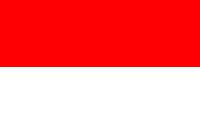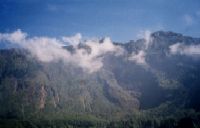Special Program for International Students
GRADUATE COURSE IN EARTH SCIENCE
& GEOENVIRONMENTAL SCIENCE
Current MEXT students
Yoga Andriana Sendjaja (Indonesia)
Email: bagong90 @unpad.ac.id
Thesis title: Across Arc chemical variation of Quaternary lavas in the West Sunda Arc, West Java, Indonesia.
Supervisor: Prof. Jun-Ichi Kimura (2006-2009).
The Sunda island arc from Java to Flores represents part of the convergent margin between the Indian Plate to the south and the Asian or China Plate to the north. Compared with most island arcs, the Java - Bali are arc is characterized by a relatively simply tectonic setting. The crust beneath Java and Bali is approximately 20 km thick, has a velocity structure intermediate between continental and oceanic, and the oldest exposed rocks are thought to be Mesozoic. In Java - Bali, the oldest widely exposed rocks are lower Tertiary shallow marine sediments. These were intruded and overlain by plutonic and related volcanic rocks in a zone only slightly south of the present day volcanic arc.
The volcanic arc extends some 6000 km from northern Sumatra to the Molucca Sea. The present Sunda island arc of Indonesia has been active since at least the mid to late – Tertiary. Beneath Java and the Java Sea to the immediate north, the Benioff zone extends to greater depths (~ 600 km). The overlying crust is slightly thinner and is probably intermediate between oceanic and continental in seismic velocity structure. The island of Java contains at least 28 active volcanoes, some of which are located in the province of west Java. The volcanoes are divided into two volcanic ranges: The Southern Volcanic Range, south of Bandung: G. Papandayan, G. Cikuray, G. Guntur and G. Galunggung, and The Northern Volcanic Range, north of Bandung: G. Tangkuban Parahu, G. Tampomas and G. Ciremai. These are young Quaternary volcanoes built upon old Quaternary bodies.
The chemical variation in major and trace elements between the frontal and rear arcs of the West Sunda shows a spatial heterogeneity of mantle source. Differences in their isotopic signatures also suggest old lithosphere affected the chemical character of the Quaternary lavas in West Java.
Bahasa Indonesia
Busur Kepulauan Sunda, Jawa sampai Flores merupakan bagian dari tumbukan lempeng India dengan lempeng Asia. Busur kepulauan Jawa Bali dicirikan oleh tatanan tektonik sederhana dibandingkan dengan busur kepulauan lainnya. Stratigrafi tertua Jawa Bali diterobos dan ditindih oleh batuan plutonik dan volkanik pada bagian selatan zona pegunungan berapi di Jawa.
Busur pegunungan api memanjang dari Sumatra sampai laut Molucca (±6000km). Kepulauan Sunda mangalami kegiatan tektonik (aktif) sejak Miosen awal-akhir. Kedalaman Benioff mencapai ~600km (laut Jawa), dengan kerak yang relatif tipis atau menengah, antara kerak samudra dengan benua bardasarkan data seismic. Kepulauan Jawa mempunyai 28 gunung api, beberapa terletak di Jawa Barat yang dibagi menjadi dua zona; Pegunungan Selatan: G.Papandayan, G. Cikuray, G.Guntur dan G.Galunggung, Pegunungan Utara: G.Tangkuban Parahu, G.Tampomas dan G.Ciremai.
Variasi kimia (Major & Trace elements) dari gunung api-gunung api Kuarter antara busur depan dan belakang di Jawa Barat mencirikan adanya heterogenitas secara spatial pada komposisi sumber mantelnya (mantle source), perbedaan isotopic juga menyimpulkan bahwa kerak mempengaruhi karakter komposisi kimia dari lava – lava Kuarter di Jawa Barat.


